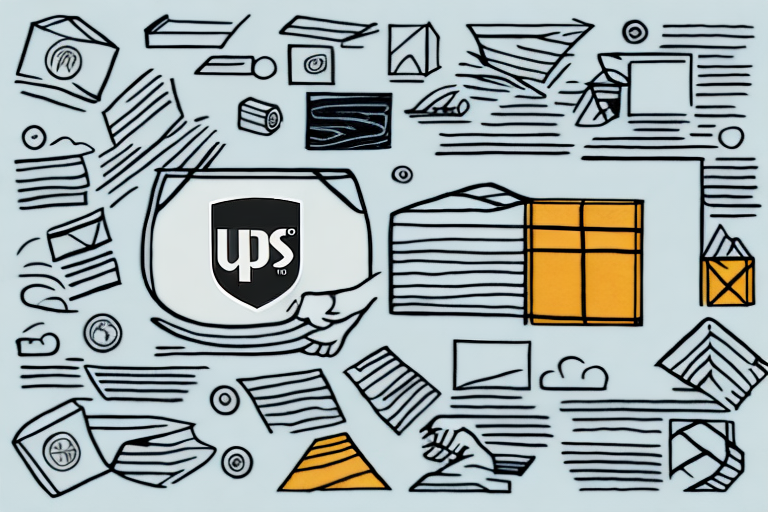How to Lower UPS Shipping Rates for Your Business
As a business owner, one of your biggest expenses is shipping. Whether you're selling products online, shipping supplies to customers, or sending documents across the country, the cost of shipping can add up quickly. If you use UPS as your shipping provider, there are several ways to lower your shipping rates and save money for your business.
Why Shipping Rates Matter for Your Business
Shipping rates are a significant cost for any business that ships products or supplies to customers. According to the Statista E-commerce Report, shipping expenses can account for up to 10% of a company's revenue. The cost of shipping affects your bottom line and can be a deciding factor for customers when they choose whether to buy from you or a competitor. It's essential to keep your shipping rates competitive to avoid losing business to companies with lower shipping rates.
Additionally, shipping rates impact customer satisfaction. Customers expect their orders to arrive quickly and at a reasonable cost. If your shipping rates are too high, customers may feel overcharged and may choose to shop elsewhere. Conversely, if your shipping rates are too low, you may not cover your shipping costs, which can hurt your profitability.
Moreover, shipping rates can vary depending on the destination and the shipping method. Understanding these differences and offering a range of shipping options can cater to diverse customer needs and preferences, helping you attract and retain more customers.
Understanding How UPS Calculates Shipping Rates
UPS calculates shipping rates based on several factors, including:
- Package Weight and Size: Heavier and larger packages typically incur higher shipping costs.
- Distance: The farther the package needs to travel, the higher the shipping rate.
- Shipping Speed: Faster shipping options like UPS Next Day Air or UPS 2nd Day Air come at higher rates compared to standard options like UPS Ground.
- Shipping Volume and Account Level: Businesses that ship in higher volumes may qualify for discounted rates based on their account status.
Understanding these factors can help you identify areas where you can save money. For instance, optimizing package size and weight can lead to significant savings. Additionally, leveraging UPS's pricing tiers based on your shipping volume can further reduce costs.
Another critical factor that affects UPS shipping rates is the type of service you choose. For example, opting for UPS Ground ensures delivery within 1-5 business days, depending on distance. If you need faster delivery, expedited options like UPS Next Day Air or UPS 2nd Day Air are available, albeit at higher costs.
UPS also offers various discounts and promotions throughout the year. For example, businesses with consistent shipping volumes may be eligible for volume discounts, and seasonal promotions like free shipping during holidays can provide additional savings. Staying informed about these discounts and promotions ensures you receive the best possible shipping rates.
Tips for Negotiating Better Shipping Rates with UPS
- Leverage High Shipping Volumes: If you ship a large volume of packages, you can negotiate lower rates by demonstrating your consistent business to your UPS account representative.
- Research Competitor Rates: Knowing the rates offered by UPS's competitors can provide leverage in negotiations for better pricing.
- Consider Prepaid Shipping Options: Prepaid shipping allows you to pay for shipping labels in advance, often resulting in lower rates.
- Explore Industry-Specific Discounts: UPS offers discounts for certain industries and business types, such as non-profits and small businesses. Inquire about any available discounts that may apply to your business.
How to Take Advantage of Volume Discounts with UPS
UPS provides volume discounts to businesses that ship a high number of packages. Small businesses that may not reach these volume levels on their own can join a shipping co-op or network to combine their shipping volume with other businesses, thereby qualifying for lower shipping rates.
Another strategy is to negotiate directly with UPS. Presenting data on your shipping volume and costs can strengthen your position during negotiations. Additionally, utilizing UPS's online tools to optimize your shipping strategy can help reduce costs further.
The Benefits of Using UPS's Online Shipping Tools
- Shipping Calculator: Compare rates for different shipping speeds and package sizes to find the most cost-effective option.
- Address Validation Tools: Ensure your packages are delivered to the correct address, reducing delivery delays and returns.
- My Choice Feature: Customize delivery preferences, such as altering the delivery address, rescheduling delivery times, or holding packages for pickup at a UPS location.
These tools not only help in saving money but also streamline your shipping processes, enhancing overall efficiency.
Utilizing UPS's Free Packaging Options to Save on Costs
UPS offers free packaging options, including boxes, envelopes, and tubes, designed to meet their shipping requirements. Using these free packaging materials can save you money by eliminating the need for oversized packaging or incurring additional fees.
Moreover, these packaging materials come pre-labeled with necessary shipping information, simplifying the shipping preparation process and reducing the risk of errors or delays.
How to Properly Package Your Shipments to Avoid Extra Fees
Avoiding extra fees is crucial for lowering shipping costs. Proper packaging ensures your shipments meet UPS's guidelines, preventing additional charges for oversized packages, incorrect labels, or packages requiring extra handling.
- Use Appropriate Packaging Materials: Protect fragile items with bubble wrap, packing peanuts, or foam inserts.
- Label Accurately: Ensure packages have clear and accurate information, including the recipient's address and contact details.
Following these steps helps ensure safe delivery and avoids extra fees associated with damaged or improperly packaged items.
Strategies for Reducing the Weight and Size of Your Packages
The weight and size of your packages significantly influence shipping rates. Implement the following strategies to reduce shipping costs:
- Optimize Packaging: Use lighter materials and compact items to fit into smaller packaging.
- Eliminate Unnecessary Materials: Remove excess packaging materials when possible, especially if the product is already packaged.
- Utilize Flat-Rate Shipping: For heavier items, flat-rate shipping options can be more cost-effective.
- Accurate Measurements: Measure items accurately and select packaging that snugly fits to avoid paying for oversized dimensions.
Additionally, using shipping calculators to compare rates for different package sizes and weights can help you choose the most economical shipping options.
Utilizing Alternative Shipping Options to Save Money
UPS offers several alternative shipping options that can be more cost-effective:
- UPS Ground: A more affordable option compared to expedited services, suitable for non-urgent shipments.
- UPS Economy: Slower delivery times in exchange for lower shipping costs.
Additionally, taking advantage of free shipping promotions, such as those offered by online retailers during specific periods or for orders exceeding a certain amount, can further reduce your shipping expenses.
How to Track and Analyze Your Shipping Costs for Optimization
Tracking and analyzing your shipping costs is essential for identifying savings opportunities. Utilize UPS's tracking and reporting tools to monitor your shipping expenses and shipments. Analyze the data to uncover patterns, such as:
- High shipping costs during peak seasons
- Specific shipping routes that incur higher expenses
Using this information, you can optimize your shipping strategy by adjusting shipping methods, renegotiating rates, or consolidating shipments to reduce overall costs.
Case Studies: Real-World Examples of Businesses Saving on UPS Shipping Costs
Real-world examples illustrate how businesses have successfully reduced their UPS shipping costs:
- Small E-commerce Company: By joining a shipping co-op with other businesses, the company accessed volume discounts, significantly lowering their shipping rates.
- Retail Business: Switching from premium shipping methods to UPS Ground resulted in substantial savings without compromising delivery times for most customers.
These case studies demonstrate the effectiveness of strategies like volume discounts and optimizing shipping methods in reducing shipping expenses.
Common Mistakes Businesses Make When Trying to Lower Their UPS Shipping Rates
Businesses often make the following mistakes when attempting to reduce shipping costs:
- Poor Packaging: Improperly packaged items can lead to extra fees for oversized or damaged packages.
- Inappropriate Shipping Options: Selecting shipping methods that do not align with business needs can result in unnecessary costs.
- Neglecting Volume Discounts: Failing to leverage available volume discounts and promotions can lead to higher shipping expenses.
Avoid these mistakes by adhering to UPS's shipping requirements, choosing the appropriate shipping options, researching competitor rates, and negotiating with your UPS account representative.
Future Trends in the Shipping Industry and How They May Impact Your Business
The shipping industry is evolving, with several trends poised to impact businesses:
- Sustainable Shipping: Increasing demand for eco-friendly packaging materials and carbon-neutral shipping options.
- Automation and Technology: Enhanced use of AI and automation in logistics to improve efficiency and reduce costs.
- Same-Day Delivery: Growing expectation for faster delivery times, influencing shipping strategies and costs.
Staying informed about these trends and adapting your shipping strategies accordingly can help your business remain competitive and continue to save on shipping costs. For instance, adopting sustainable practices not only reduces costs but also appeals to environmentally conscious consumers.
How Outsourcing Fulfillment Can Help You Save on Shipping Costs in the Long Run
Outsourcing fulfillment can lead to long-term savings on shipping costs. By partnering with a third-party logistics (3PL) provider, you can:
- Access Discounted Shipping Rates: 3PL providers often have established relationships with carriers like UPS, securing lower rates due to higher shipping volumes.
- Benefit from Economies of Scale: Consolidated shipments and optimized logistics processes can reduce overall shipping expenses.
- Enhance Operational Efficiency: 3PL providers handle packaging, labeling, and tracking, freeing up your resources to focus on core business activities.
By leveraging the expertise and resources of a fulfillment provider, your business can optimize its shipping strategy, reduce costs, and improve overall efficiency.
By implementing these strategies and tips, you can lower your UPS shipping rates and save money for your business. Stay informed about UPS's shipping options and requirements, and regularly evaluate your shipping strategy to identify areas for optimization and cost reduction. For more detailed assistance, visit ShipScience.




















